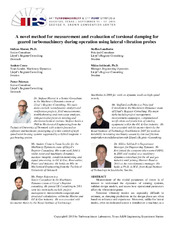| dc.description.abstract | Measurement of the modal parameters of rotors is of interest to understand the dynamics of rotating systems, validate design models, and assess how operational parameters affect the vibration response. Torsional vibratory modes are especially difficult to estimate, as damping predictions in the design phase are often based on reference and experience. Moreover, unlike for lateral modes, often no dedicated sensor is installed on a machine; as a consequence these often go undetected. However in geared trains it is possible to identify torsional dynamics by observing proximity probe data, due to the gear mesh torsional-lateral coupling. Sometimes it is possible to perform basic estimation of torsional damping by evaluating the vibration decay when the machine starts, trips, or in case of a sudden change in operating conditions. However such assessments are only possible for specific operating conditions and may fail to identify issues if the overall damping is not constant throughout the operating range, as for example in such cases as: Machines equipped with gearbox running on hydrodynamic bearings, where the damping depends on the oil film dynamic characteristics, Grid connected machines (motors, generators), where damping from electromagnetic coupling may change with load as well as being influenced by electrical grid stability, Machines with special couplings, e.g. variable speed couplings or polymeric couplings, with material damping dependent on operational parameters, e.g. load, VSD motors, where the torsional dynamic becomes a function of the drive control loop settings (also applies for generators AVR settings). Traditional experimental modal testing techniques rely on controlled and measured excitation together with measured responses in order to identify the mode shape, natural frequency and damping factor of each mode. Such assessments are in practice very difficult to obtain in actual operating conditions, principally due to the challenges of quantifying the excitation force. Operational modal analysis (OMA) identifies the modal parameters of a system from measurement of response to unmeasured or unknown excitation. OMA has proven successful over the past several decades on non-rotating structures and has in the past years rose in prominence in the rotordynamic community. Through examples based on various measurement and case studies, this paper will show and demonstrate how OMA can be used to: Successfully identify the damping of not only the fundamental torsional mode but also higher order torsional modes, Validate design models by tracking torsional damping variations depending on operating conditions, Aid operators and OEMs for machine tuning during commissioning, Provide an essential tool for troubleshooting. | en |


